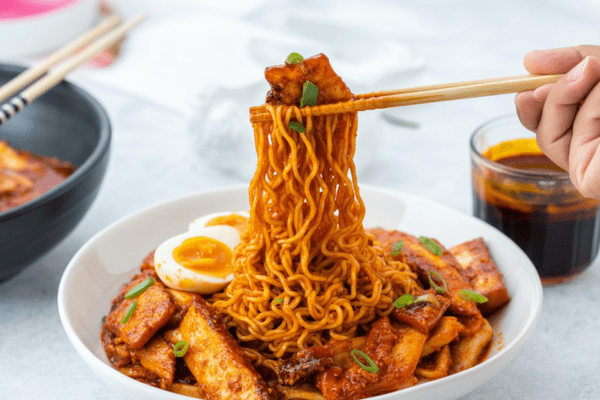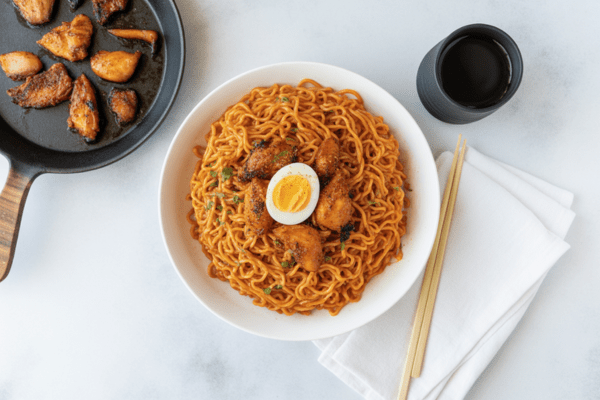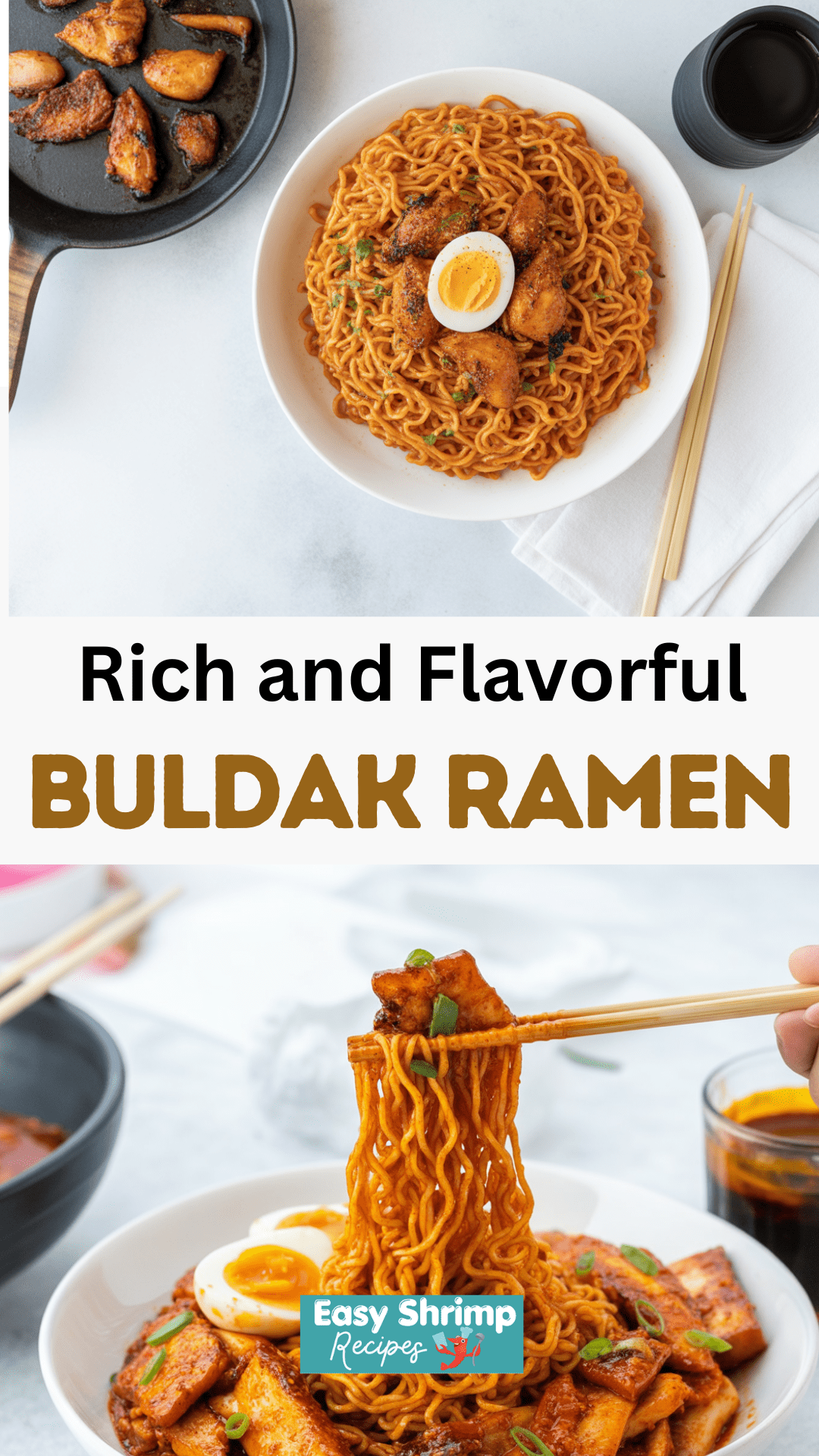If you’re anything like me, you love the idea of buldak ramen—the bold, fiery, saucy noodles that feel like a dare to eat. But sometimes those packaged versions are so hot they’re basically an endurance test.
That’s why I started making my own version at home. I wanted all the deep, smoky, spicy-sweet Korean flavor, but tuned to my own heat tolerance. Homemade buldak ramen lets you control the burn, while still delivering that addictive glossy, savory sauce that clings to every noodle.
It’s the perfect fix for a late-night craving, a cold evening when you want to sweat a little, or even a quick lunch with friends who appreciate bold flavors.

Buldak Ramen (Korean Fire Noodles, Your Way)
I’ve always had a bit of a love-hate relationship with Buldak Ramen. On one hand, it’s insanely flavorful, rich, and satisfying. On the other, it’s so spicy it makes my eyes water — and yet I keep going back for more.
That’s exactly why I started making a homemade version. I get to keep all the bold flavor, the glossy noodles, the addictive heat… but I’m in charge of how spicy it gets. If you’re a fan of Korean fire noodles but want more control over the burn, this one’s for you.
What is Buldak, Exactly?
Buldak (불닭) literally means “fire chicken” in Korean — and it’s just as dramatic as it sounds. The dish is made of bite-sized pieces of chicken tossed in a fiery sauce made from gochugaru (Korean chili flakes), gochujang (Korean chili paste), soy sauce, garlic, ginger, and a hint of sweetness from rice syrup or sugar.
It’s relatively new to the Korean food scene, becoming popular in the early 2000s when buldak restaurants started popping up. Samyang then turned it into their wildly successful instant noodles, and the rest is spicy noodle history.
At Korean BBQ joints, you’ll often find buldak served sizzling on a hot plate, sometimes smothered with melted cheese. It’s hot — in every sense of the word — and addictive.
What Is Buldak Ramen?
Buldak Ramen is the noodle version of that same spicy chicken dish. The instant version from Samyang (yes, the one that nearly broke the internet with all the YouTube spice challenges) comes with cooked ramen tossed in a thick, glossy red sauce.
Unlike most ramen which are soup-based, buldak ramen is dry and saucy. You boil the noodles, drain them, then mix with the sauce. The result? Chewy, springy noodles coated in sweet-heat magic.
There are different flavor variations now — cheese, carbonara, curry, even 2x or 3x spicy — but the base remains the same: heat, umami, and a surprising layer of sweetness underneath it all.
Homemade Buldak Ramen (Flavor Without the Fire Alarm)
When I make it at home, I stick to the spirit of the dish — spicy, saucy, and rich — but make it more friendly for weeknight cravings. No tears, just good vibes.
Here’s how I do it:
Mix the sauce right in your noodle bowl:
- 1 tbsp gochujang (pick mild or spicy)
- 1 tbsp gochugaru (coarse flakes are best)
- 1 tbsp soy sauce
- 2 tsp sugar
- 1 tsp chicken bouillon powder
- 1 garlic clove, finely grated
- ¼ tsp black pepper
Cook the noodles in boiling water until chewy. I usually use a pack of instant noodles like Nongshim’s Shin Ramyun and toss the seasoning packet. You can also use plain udon, yakisoba, or even spaghetti in a pinch.
Toss the noodles directly into the bowl with sauce. I always save a splash of noodle water to loosen it up and help coat the noodles evenly. The result? Perfectly sticky, saucy noodles every single time.

Ingredient Notes (What Makes It So Good)
Gochujang – This fermented chili paste brings the heat and that signature depth of flavor. It’s spicy, yes, but also earthy and slightly sweet. It’s available in squeeze bottles now, which I love for convenience.
Gochugaru – Korean chili flakes that are smoky, fruity, and not overwhelmingly spicy. Look for “medium” if you’re new to them — the texture and flavor are so unique, they really make the dish.
Soy Sauce – I use Korean soy sauce when I can find it, but Japanese or light soy sauce works too.
Garlic – A little raw garlic in the sauce gives a nice kick. I usually stick with one clove, but you can add more if you love that sharp, spicy edge.
Sugar – It’s the balance that makes this work. The sweetness cuts the spice and brings everything together. You can swap it with honey or agave, but regular white sugar does the trick just fine.
Chicken Bouillon Powder – This adds a savory depth, almost like instant stock. A little goes a long way in rounding out the flavor.
Taming the Heat (If You’re Not a Spice Warrior)
One of the biggest perks of the homemade version is dialing the spice up or down. Here’s how I keep it manageable without losing flavor:
- Use mild gochugaru or reduce the amount.
- Start with ½ tbsp gochujang if you’re new to it.
- Add a slice of cheese or stir in a spoonful of butter to mellow it out.
- Top it with a soft-boiled egg — that creamy yolk really balances the heat.
This way, even spice-shy eaters can still enjoy the rich buldak flavor without feeling like they’ve set their mouths on fire.
Topping & Serving Ideas
Let’s be honest — toppings are half the fun. Here’s what I usually pile on:
- Melty cheese – Mozzarella or even a slice of processed cheese is traditional and balances the spice perfectly.
- Soft-boiled or fried egg – The yolk adds a creamy richness that ties everything together.
- Green onions or sesame seeds – For a bit of freshness and crunch.
- Kimchi – For a tangy, fermented kick on the side.
- Crispy seaweed or furikake – If you want a little texture and umami lift.
Pair it with some iced barley tea or milk tea if you’re feeling the heat!

FAQs
How spicy is homemade buldak ramen?
It can be as spicy as you want! Start mild and build your way up. The original Samyang version is about 4,000 Scoville units, but homemade gives you full control.
Can I make it vegan?
Absolutely. Just skip the chicken bouillon and use mushroom or vegetable bouillon instead. Everything else is plant-based.
What kind of noodles should I use?
Any instant noodles work. I like thick, chewy ones like Shin Ramyun or plain Korean ramen. Even spaghetti will do in a pinch.
Does this store well?
It’s best fresh. But if you have leftovers, store them in an airtight container and reheat in a pan with a splash of water to loosen the sauce.
Final Thoughts
Buldak Ramen is one of those meals that scratches every itch — it’s fast, bold, comforting, and just a little wild. And making it at home lets you enjoy all that without needing a glass of milk every two bites.
I keep a little jar of the sauce mix ready in the fridge for late-night cravings, and every time I stir those glossy noodles together, I’m reminded that great flavor doesn’t have to take hours.
So next time you’re craving something spicy, skip the store-bought version and make this instead. It’s cozy, craveable, and you’re in full control of the heat.
Buldak Ramen Recipe

This Buldak Ramen is the perfect spicy noodle fix—customizable heat, bold flavor, and ready in minutes.
Ingredients
- 1 tbsp gochujang or to taste, see notes
- 1 tbsp gochugaru
- 2 tsp soy sauce
- 1 tsp chicken bouillon
- 1 tbsp rice vinegar
- 1 tsp garlic powder
- 1 tsp sugar
- 1/2 tsp toasted sesame oil
- 1 portion cooked noodles of choice
- 2-4 tbsp noodle water as needed
Instructions
- In a small bowl, stir together the gochujang, gochugaru, soy sauce, chicken bouillon, rice vinegar, garlic powder, sugar, and toasted sesame oil until smooth and fully combined.
- Cook your noodles according to package directions. Before draining, save about 1/4 cup of the cooking water.
- Toss the hot noodles with the sauce, adding some of the reserved noodle water to help the sauce coat everything evenly and smoothly.
- Finish with toppings like sliced green onions, toasted sesame seeds, or crushed seaweed if desired—and dig in while it’s hot.
Notes
Nutrition Information
Yield
1Serving Size
1Amount Per Serving Calories 409Total Fat 5gSaturated Fat 1gTrans Fat 0gUnsaturated Fat 3gCholesterol 0mgSodium 1968mgCarbohydrates 78gFiber 4gSugar 15gProtein 13g
Easy Shrimp Recipes.com, occasionally offers nutritional information for recipes contained on this site. This information is provided as a courtesy and is an estimate only. This information comes from online calculators. Although allchickenrecipes.com attempts to provide accurate nutritional information, these figures are only estimates.

